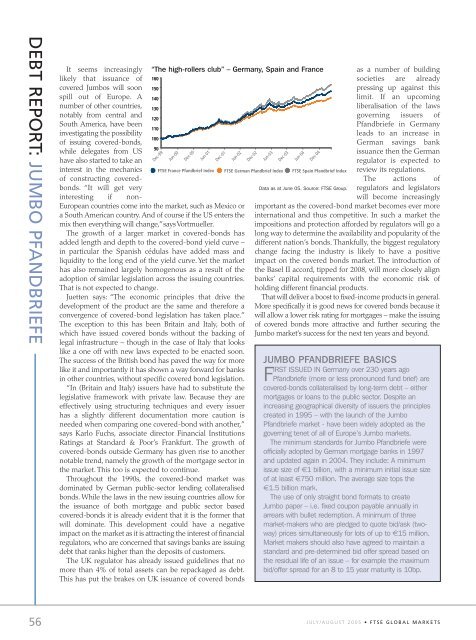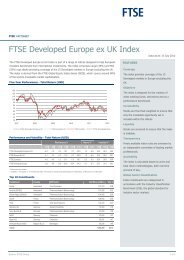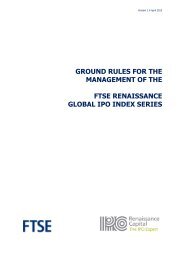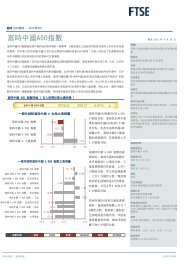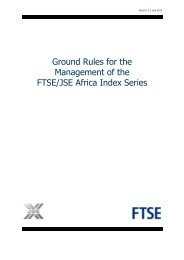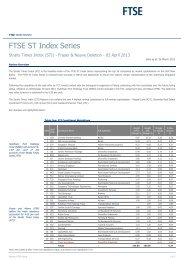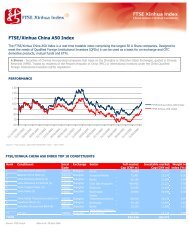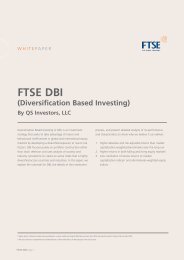Create successful ePaper yourself
Turn your PDF publications into a flip-book with our unique Google optimized e-Paper software.
DEBT REPORT: JUMBO PFANDBRIEFE<br />
56<br />
It seems increasingly<br />
likely that issuance of 160<br />
covered Jumbos will soon 150<br />
spill out of Europe. A 140<br />
number of other countries, 130<br />
notably from central and<br />
120<br />
South America, have been<br />
110<br />
investigating the possibility<br />
100<br />
of issuing covered-bonds,<br />
90<br />
while delegates from US<br />
have also started to take an<br />
interest in the mechanics<br />
of constructing coveredbonds.<br />
“It will get very<br />
interesting if non-<br />
European countries come into the market, such as Mexico or<br />
a South American country. And of course if the US enters the<br />
mix then everything will change,”says Vortmueller.<br />
The growth of a larger market in covered-bonds has<br />
added length and depth to the covered-bond yield curve –<br />
in particular the Spanish cédulas have added mass and<br />
liquidity to the long end of the yield curve. Yet the market<br />
has also remained largely homogenous as a result of the<br />
adoption of similar legislation across the issuing countries.<br />
That is not expected to change.<br />
Juetten says: “The economic principles that drive the<br />
development of the product are the same and therefore a<br />
convergence of covered-bond legislation has taken place.”<br />
The exception to this has been Britain and Italy, both of<br />
which have issued covered bonds without the backing of<br />
legal infrastructure – though in the case of Italy that looks<br />
like a one off with new laws expected to be enacted soon.<br />
The success of the British bond has paved the way for more<br />
like it and importantly it has shown a way forward for banks<br />
in other countries, without specific covered bond legislation.<br />
“In (Britain and Italy) issuers have had to substitute the<br />
legislative framework with private law. Because they are<br />
effectively using structuring techniques and every issuer<br />
has a slightly different documentation more caution is<br />
needed when comparing one covered-bond with another,”<br />
says Karlo Fuchs, associate director Financial Institutions<br />
Ratings at Standard & Poor’s Frankfurt. The growth of<br />
covered-bonds outside Germany has given rise to another<br />
notable trend, namely the growth of the mortgage sector in<br />
the market. This too is expected to continue.<br />
Throughout the 1990s, the covered-bond market was<br />
dominated by German public-sector lending collateralised<br />
bonds. While the laws in the new issuing countries allow for<br />
the issuance of both mortgage and public sector based<br />
covered-bonds it is already evident that it is the former that<br />
will dominate. This development could have a negative<br />
impact on the market as it is attracting the interest of financial<br />
regulators, who are concerned that savings banks are issuing<br />
debt that ranks higher than the deposits of customers.<br />
The UK regulator has already issued guidelines that no<br />
more than 4% of total assets can be repackaged as debt.<br />
This has put the brakes on UK issuance of covered bonds<br />
“The high-rollers club” – Germany, Spain and France<br />
Dec-99<br />
Jun-00<br />
Dec-00<br />
Jun-01<br />
Dec-01<br />
Jun-02<br />
as a number of building<br />
societies are already<br />
pressing up against this<br />
limit. If an upcoming<br />
liberalisation of the laws<br />
governing issuers of<br />
Pfandbriefe in Germany<br />
leads to an increase in<br />
German savings bank<br />
issuance then the German<br />
regulator is expected to<br />
review its regulations.<br />
The actions of<br />
Data as at June 05. Source: <strong>FTSE</strong> Group. regulators and legislators<br />
will become increasingly<br />
important as the covered-bond market becomes ever more<br />
international and thus competitive. In such a market the<br />
impositions and protection afforded by regulators will go a<br />
long way to determine the availability and popularity of the<br />
different nation’s bonds. Thankfully, the biggest regulatory<br />
change facing the industry is likely to have a positive<br />
impact on the covered bonds market. The introduction of<br />
the Basel II accord, tipped for 2008, will more closely align<br />
banks’ capital requirements with the economic risk of<br />
holding different financial products.<br />
That will deliver a boost to fixed-income products in general.<br />
More specifically it is good news for covered bonds because it<br />
will allow a lower risk rating for mortgages – make the issuing<br />
of covered bonds more attractive and further securing the<br />
Jumbo market’s success for the next ten years and beyond.<br />
Dec-02<br />
<strong>FTSE</strong> France Pfandbrief <strong>Index</strong> <strong>FTSE</strong> German Pfandbrief <strong>Index</strong> <strong>FTSE</strong> Spain Pfandbrief <strong>Index</strong><br />
Jun-03<br />
Dec-03<br />
Jun-04<br />
Dec-04<br />
JUMBO PFANDBRIEFE BASICS<br />
FIRST ISSUED IN Germany over 230 years ago<br />
Pfandbriefe (more or less pronounced fund brief) are<br />
covered-bonds collateralised by long-term debt – either<br />
mortgages or loans to the public sector. Despite an<br />
increasing geographical diversity of issuers the principles<br />
created in 1995 – with the launch of the Jumbo<br />
Pfandbriefe market - have been widely adopted as the<br />
governing tenet of all of Europe’s Jumbo markets.<br />
The minimum standards for Jumbo Pfandbriefe were<br />
officially adopted by German mortgage banks in 1997<br />
and updated again in 2004. They include: A minimum<br />
issue size of €1 billion, with a minimum initial issue size<br />
of at least €750 million. The average size tops the<br />
€1.5 billion mark.<br />
The use of only straight bond formats to create<br />
Jumbo paper – i.e. fixed coupon payable annually in<br />
arrears with bullet redemption. A minimum of three<br />
market-makers who are pledged to quote bid/ask (twoway)<br />
prices simultaneously for lots of up to €15 million.<br />
Market makers should also have agreed to maintain a<br />
standard and pre-determined bid offer spread based on<br />
the residual life of an issue – for example the maximum<br />
bid/offer spread for an 8 to 15 year maturity is 10bp.<br />
JULY/AUGUST 2005 • <strong>FTSE</strong> GLOBAL MARKETS


